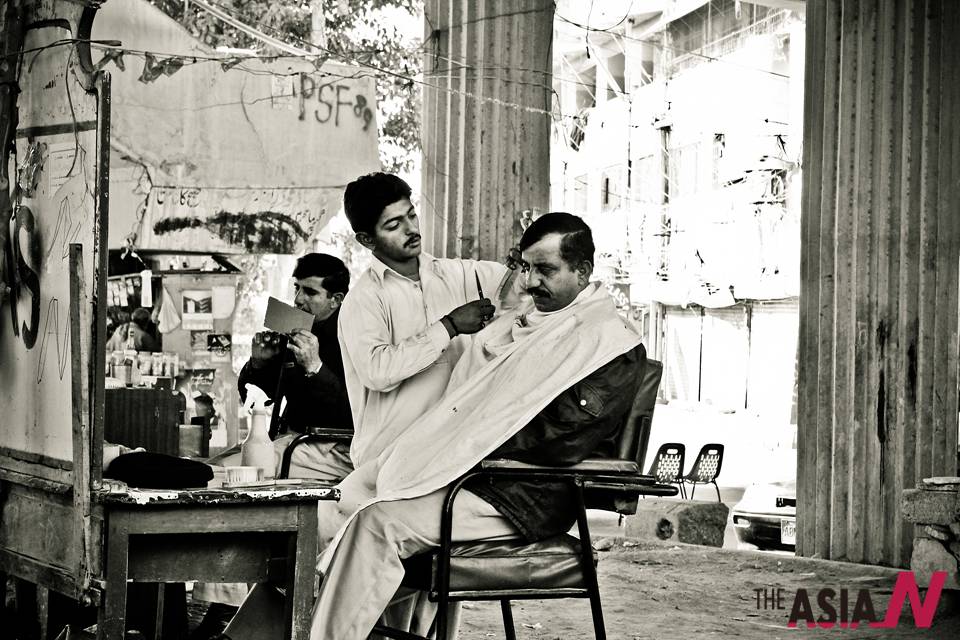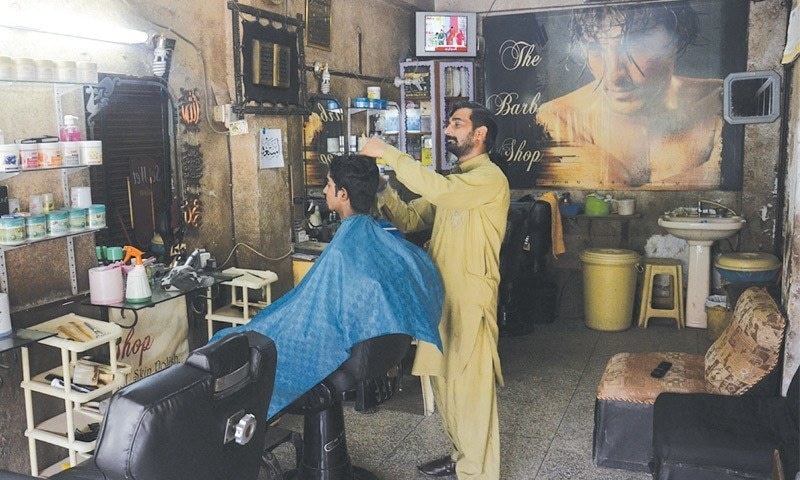I now live in Boston, USA and among the personal things I simply have to find time for (besides eating and doing my laundry) is getting a haircut every few weeks or so. I got a haircut today and despite paying many times more than what I would typically pay back home in Pakistan, I came back disappointed.
The whole experience was a disappointment – no personal connection, no conversation with anybody else at the shop, and a blank stare at a wide mirror is all I got for my 45 minutes worth.
And that reminded me so much of my local hajjam or naai (barber) from Karachi. Actually I remember two barbers from Karachi. One we called Khalifa (my dad once told me all hajjams in the Urdu speaking parts of India were called Khalifas) and he used to come to our house for a mass hair-trimming every month or so.
We would put a chair out in the garage, all the boys and men in the house would practically line up, and he would get to work with his scissors and a simple razor. He would leave a few hours later with a decent chunk of change in his pocket, and a warm feeling in the hearts of all those who interacted with him. He was also good at giving massages, but that required a special appointment. Not to forget, he was also the master called for special occasions, such as the first hair-shaving of a newborn.
And then I grew up and it somehow became embarrassing to be sitting in the house garage and getting a haircut. So I graduated to a local hair ‘salon’ (somehow that word is usually misspelled on entrances to hairdressers), and found a place I still love to go to when I can.
A small shop, no larger than 10 ft x 20 ft with one side plastered with mirrors, two black fake leather upholstered salon chairs (with the fancy hydraulic lift I so loved being on), and a bench on the other side for those not getting a haircut to wait. He also had a radio that was usually set to news or Islamic recordings. This was among the better of three choices in my neighborhood. The other two were dangerously close to street-side chicken meat stores (if you live in Karachi you would know exactly what I am talking about), and in the absence of air conditioning the smell was a bit too much to bear for an extended period of time.
Bashir, who worked at this particular place for decades it seems, always offered chai as though he had several servants running around the shop helping him. The reality was that if you did say yes, either he would have to leave himself in the middle of a haircut, or would have the young boys playing cricket outside do him a favor and place an order with the nearby canteen. Such was the quality of his service.

The inside of his little workplace was decorated with many caligraphed and framed verses from the Quran, and ofcourse posters of Asian men (probably from Singapore) wth awesome hair stylings. I tried fruitlessly for years to get him to make me look like one of the guys on the posters, but it never worked. I have some embarassing photographs of myself from those days.
The naai’s shop (hajjam, khalifa or the barber) was such a cool place to go to, especially on the weekends. People would sit there and chat about topics that were both stimulating and at the same time mundane (kind of what we do on this blog!).
The chai would arrive and the conversations only seemed to get louder despite the distraction caused by sipping of the tea. Politics was always a favorite topic, not just national and international geopolitics featured in newspaper headlines, but all the way down to the local feuds between the shop owners and mosque Imams. The barber’s job seemed to include listening to everyone and politely agreeing with the eldest person in his shop.
This may be a phenomena particular to Karachi but the barbershop was somehow also where local political movers and shakers, like the mohalla political activists, would meet regular folk and gather support for the next demonstration or rally. It was simply the place to be and to be known at.
I was in Karachi again a few weeks ago and was thrilled to go back to Bashir’s salon. He was not there but his son seemed to have taken over the shop. You see him in the first photo here. I miss Bashir, and his comments such as “you had better hair before you started using fancy western shampoos“.
But the experience at his shop remains a fulfilling one. I went there several times in the few weeks I was there, sometimes literally just to relax and have a moment to reflect, and at other times just to hear what others around me were talking about. If you are ever in Karachi, try and make a visit to a barbershop, even if you don’t need a haircut. In an otherwise super busy mega-city, the barber shop still remains a place of comfort and quaintness.
(This is a re-post; was originally posted at ATP on August 16, 2006).




















































Ayesha: It would be terrific to learn what goes on in the women beauty parlors and salons. Is that a place for mohalla women to gather? Probably not as often as men need to vist thehairdresser, right?
I have had the pleasure of being dragged to one several times by members of my family, but in each case I was forced to stand outside and wait in vain. The inside certainly looked more colorful, with more mirrors and lighting (less florescent tube-lights), and certainly better smelling than chambeli kaa tael.
Bilal. I enjoyed reading your article. I didn’t like going to a ‘naai’ shop because until Grade X I didn’t have a choice for my hair-cut. My father made sure that I got a very sharp hair-cut. I on the other hand always wanted to look like a ‘hero’ as were my other class fellows. Our ‘naai’ ran a business on a sidewalk (footpath) from a folding ‘khokha’. This ‘khokha’ used to fold in a container shape and opened into a dressing table and a mirror which had a ‘lehr’ (wave) in it. Therefore everyone who went their for haircut actually got a different haircut than what they thought they were getting. This ‘naai’ used to charge a princely sum of Rs 5 for an adult cut and Rs 2 for children. His ‘khokha’ was also a socializing place for street people where everything from presidential elections to local match-making was discussed.
A hair saloon in Karachi is called ‘Hairport’ which I think is a very creative name :)
Bilal,
Interesting post.
It’s amusing, though, to see you guys feeling so nostalgic about your respective Naiis back home. Getting a haircut is something I do not look forward to. I consider it as a necessary chore — dull and even uncomfortable sometimes.
When I moved to Islamabad a few years ago and needed a haircut someone suggested Dickson Hairdresser because of its proximity to where I lived. Impressed with the highly Anglo-Saxon sounding name and expecting a clean and efficient service, I went there. It was a small, ordinary shop with two customer chairs — both empty. The two barbers were idling on a bench, one flipping through a picture magazine and other admiring himself in one of the mirrors. I wondered who of the two would answer to the name Dickson, but as it turned out one was Ramzan and other Nadeem. Who was Dickson then, I inquired. None! They had just picked the name because it sounded good, they told me.
It was summer and hot. Only a ceiling fan lazily stirred the air. But Ramzan turned it off too, he said, to prevent from clipped hair flying into my face. After about 30 or 40 minutes I came out of the shop perspiring and feeling very itchy in the neck. When I mentioned this to a friend he suggested I try John Hair dresser next time, located in a fancy hotel!
Nice post !
The best part which i like during the haircut is Naii’s art of engaging you in a discussion. I realized it when i came here and got my all hair cuts as if a sculpurist is trying to fix sculpture’s hair.
Mus:
Naii had a great role in our rural life. In addition to hair cut, they used to do cook DEG, circumcisions and even the marriage invitations were extended through them, when there was no trend of printed invitation cards in rural areas.
A village (gaon) was comprised of clustered communities (basti) like cobblers cluster (mochi basti), carpenter cluster (darkhan basti), blacksmith cluster (lohar basti) and so on so forth.
But now these trends are rapidly fading away from our rural culture.